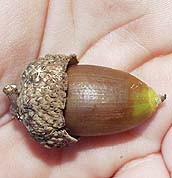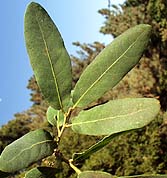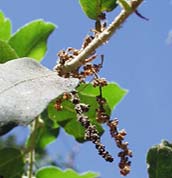How to Identify An Engelmann Oak |
|
|
Here are some of the distinguishing characteristics of the Engelmann Oak. Because most everyone is Southern California is familiar with the Coast Live Oak, the other great oak of our region, we have contrasted the features of the Engelmann Oak with that tree. |
|
|
|
The Engelmann has a wild untamed character compared to the solid, serious Coast Live Oak. The Coast Live Oak is dense and orderly. The Engelmann sprawls with twisted branches reaching out to the sky. Contrasting markedly with the thick foliage of the Coast Live Oak, its open airy canopy catches the sun in unique ways. The Engelmann is often found in open prairies in nature more like Savannahs than the clumps of the Coast Live Oak. |
|
|
The Engelmann has stubby brown acorns compared to the more elongated acorns of the Coast Live Oak. Both trees are prodigious in the thousands of acorns they drop to produce a single successor. |
|
|
The Engelmann Oak has long elliptical green/gray leaves. Sometimes they almost seem blue like the Engelmann's cousin, the Blue Oak; sometimes they are almost fiddle-shaped. In contrast the Coast Live Oak has dark green oval leaves with prickly edges. Engelmanns are sometimes hard to definitively identify because they hybridize with other oak species, but with a bit of study you will quickly develop a feel for the great trees. |
|
|
Here is the flower of the Engelmann Oak. |
|
|
The Engelmann has a distinctive mottled bark. |
Where to Find Engelmann Oak Specimens |
|
 |
|
Stewards of the Arroyo Seco, PO Box 92722, Pasadena, CA 91109-2722 (323) 405-7326 engelmann@arroyoseco.org | |




